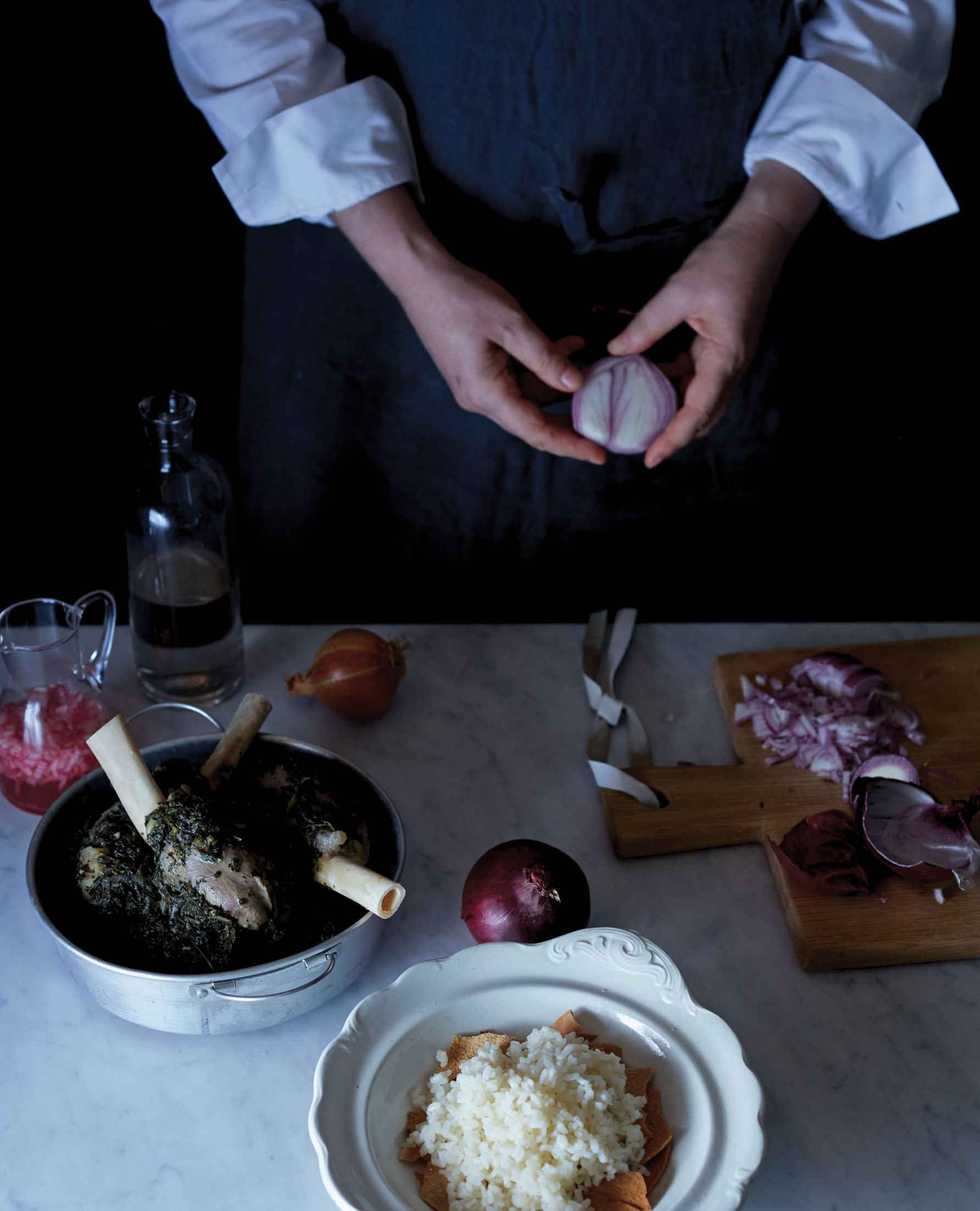MULUKHIYAH ‘ALA LAHM
LEBANON

The mere mention of mulukhiyah transports me back to prewar Beirut summers when I used to spend my days lazing at the St. Georges beach—the St. Georges was the ritziest hotel in Beirut in those days, and as it was right on the sea, it had an elegant beach attached to it where le tout Beirut could be seen taking in the sun, water-skiing, or dining in the beach restaurant. One of the restaurant’s star daily specials was mulukhiyah. On that given day, the restaurant would fill up, not only with the habitués—the beach was membership only—but also with nonmembers invited by their member friends to feast on this elaborate preparation. I hated the slimy texture of mulukhiyeh then and stayed by the pool while everyone went to lunch. Later, when I started to write about food, my mother shared the secrets for how to avoid the “sliminess.” First, it is essential to pick the leaves off the stems without leaving any stems on them because that is where the mucilaginous substance lurks. Then, the lemon juice should be added to the broth before the leaves; and finally and just as important, it is essential not to overboil the leaves, otherwise they sink in the broth.
This can be made with dried, frozen, or fresh mulukhiyah. The dried leaves will taste quite different from the frozen and both are in my opinion inferior to the fresh leaves. So, try to source fresh mulukhiyah if you can. It is a good idea to prepare the fresh leaves before starting to cook the meat.
SERVES 6 TO 8
FOR THE LAMB
4 lamb shanks (3 pounds 5 ounces/1.5 kg total)
2 medium onions (10½ ounces/300 g total), peeled
2 sticks cinnamon
1 tablespoon sea salt
FOR THE MULUKHIYAH
3½ ounces (100 g) dried mulukhiyah leaves, or 1 pound 5 ounces (600 g) frozen mulukhiyah, or 1 pound 5 ounces (600 g) fresh leaves on the stem
6 tablespoons (90 g) unsalted butter
10 cloves garlic, minced to a fine paste
1 bunch cilantro (7 ounces/200 g), most of the bottom stems discarded, finely chopped
½ teaspoon ground coriander
Juice of 2 lemons, or to taste
1 teaspoon ground allspice
½ teaspoon ground cinnamon
½ teaspoon finely ground black pepper
Sea salt
FOR SERVING
½ cup (125 ml) apple cider vinegar
1 large red onion, very finely chopped
2 medium pita breads, split horizontally into disks, toasted and broken into bite-size pieces
Lebanese/Syrian Vermicelli Rice
1. To cook the lamb: Put the shanks in a large pot. Add 7½ cups (1.75 liters) water and bring to a boil over medium-high heat, skimming the froth from the surface. Add the onions, cinnamon sticks, and salt. Reduce the heat to medium-low and let simmer for 1 hour, or until the shanks are done.
2. To prepare the mulukhiyah: For dried: Crumble the leaves with your hands and discard the stems if any. For frozen: Take them out of the freezer 30 minutes before you are ready to drop them into the broth to let them defrost. For fresh: Pick the leaves off the stems, making sure you do not leave any stem on them. Wash and dry them in a salad dryer, then spread them onto clean kitchen towels so that they dry completely. Chop the leaves into very fine slivers (see Note), doing this in small batches so as not to bruise them, and use a razor-sharp knife to slice them into 1/16-inch (1.6 mm) slivers. Place in a large bowl and cover with a clean kitchen towel until you are ready to use them.
3. Melt the butter in a medium skillet over medium heat. Add the garlic, cilantro, and ground coriander and sauté for a minute or so, until the cilantro has wilted but not turned brown. Take off the heat.
4. Reserving the broth, pull the meat and boiled onions out of the pot. Place the meat in a large bowl and cover. Put the onions in a smaller bowl. Discard the cinnamon sticks. Mash the onions into a puree and mix with the garlic/cilantro mixture. Measure out 5¼ cups (1.25 liters) of the meat broth and pour into a clean large pot.
5. Bring the broth to a boil over medium heat. Add the lemon juice, then the chopped (or whole) mulukhiyah. Season with the allspice, cinnamon, pepper, and salt to taste and bring back to a boil. Stir in the garlic/cilantro mixture and let bubble gently: 10 minutes if using dried leaves, 2 to 3 minutes if using frozen, and 5 minutes if using fresh leaves. Do not boil any longer as the mulukhiyah will sink in the broth and not stay suspended in it.
6. To serve, transfer the shanks to a cutting board and pick the meat off the bones, discarding any skin and fat. Tear the meat into bite-size pieces and transfer to a medium serving dish. Keep warm.
7. Put the vinegar in a small serving bowl. Add the chopped onion and mix well. Put the toasted bread in another medium serving dish and the rice in another. Pour the mulukhiyah into a soup tureen.
8. Mulukhiyah is a composite dish and it is served in soup plates with each diner making the layers to his/her taste by first spreading a few pieces of toasted bread on the plate, then spooning a little rice over the bread, scattering a few pieces of meat on top, and covering generously with mulukhiyah. The onion/vinegar mixture is drizzled over the top and can be omitted, but it gives the mixture a nice kick.
NOTE: You can also use the leaves whole as they do in the South and drop them as they are in the broth, which will obviously save you a fair amount of time.